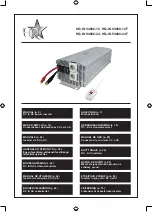
© 2010 Magnum Energy, Inc.
38
4.0 Maintenance and Troubleshooting
Troubleshooting
The MMS Series inverter/charger is a fairly simple device to trouble-
shoot. There are only two active circuits (AC and DC), as well as a
charging circuit. The following chart is designed to help you quickly
pinpoint the most common inverter and charger faults.
Table 7, Troubleshooting Guide
Symptom
Possible cause
Recommended Solution
Low Battery Voltage
(the status indicator
blinks on 1 time every
4 secs)
The battery voltage level has dropped
below the Low Battery Cut Out
(LBCO) set-point for more than one
minute (10.0VDC = LBCO default
setting).
Battery voltage is too low. Check fuses/
circuit-breakers and cable connections.
Check battery voltage at the inverter's
terminals. Your batteries may need
to be charged, this fault condition will
automatically clear when the battery
voltage exceeds 12.5VDC.
High Battery Voltage
(the status indicator
blinks on 2 times
every 4 secs)
The battery voltage is above 15.5
VDC. The inverter automatically
resets and resumes operation when
the battery voltage drops below 15.5
VDC.
This condition usually occurs only when
an additional charging source (alternator,
solar panels or other external charging
sources) is used to charge the battery
bank. Reduce or turn off any other
charger to the inverter batteries to allow
the voltage level to drop.
Over-temperature
condition
(the status indicator
blinks on 3 times
every 4 secs)
The internal temperature of the
inverter has risen above acceptable
limits; caused by loads too great for
the inverter to operate continuously,
or by lack of ventilation to the
inverter. When the unit has cooled, it
will automatically reset and resume
operation.
Reduce the number of electrical loads
that you are operating, this will avoid a
repeat Over-temp shutdown if the cause
was too many loads for the ambient
conditions.
Check ventilation around the inverter,
ensure cool air is available to pass-thru
the inverter.
AC Overload
(the status indicator
blinks on 4 times
every 4 secs)
The inverter has turned off because
the connected loads are larger than
the inverters output capacity or the
output wires are shorted.
Reduce the AC loads connected to the
inverter or remove all AC output wiring
and restart the inverter.
Internal fault
(the status indicator
blinks on 5 times
every 4 secs)
This fault occurs when an internal
fault is detected.
To clear this fault, an inverter reset
is required. Remove DC power to the
inverter or press and hold down the
power switch on the inverter for 15
seconds (until the green Status LED
comes on). If this fault does not clear, the
unit will need to be serviced.
Inverter's status light
is off.
Inverter is switched OFF or there is
no DC voltage (battery) connected to
inverter.
Switch the inverter ON. Connect a battery
with correct voltage to the inverter.
AC input won't connect
(AC IN on remote
blinks)
The incoming AC voltage will not
be accepted if it is below the VAC
Dropout setting (80VAC = VAC
Dropout default setting).
Check the incoming AC voltage to the
input of the inverter, ensure it is present
and above the VAC dropout level.
Appliances turn off
and on; or there is low
AC output power.
Loose AC output connections.
Tighten AC output connections.
Loose / corroded battery cables.
Clean and tighten all cables.
Low batteries.
Recharge or replace batteries.
Inverter AC output
voltage is too low or
too high when using
an AC voltmeter.
Wrong type of voltmeter used (will
display 90 VAC to 130 VAC depending
on the battery voltage).
Most meters are made to read Average
AC voltage. The AC output of the MM is a
"modi
fi
ed" waveform which requires using
a “true” RMS voltmeter to correctly read
the output voltage.
While charging, the
DC charge voltage is
higher or lower than
expected.
If the Battery Temperature Sensor is
installed, it will increase or decrease
the DC voltage level depending on
temperature around the battery
sensor.
This is normal.









































